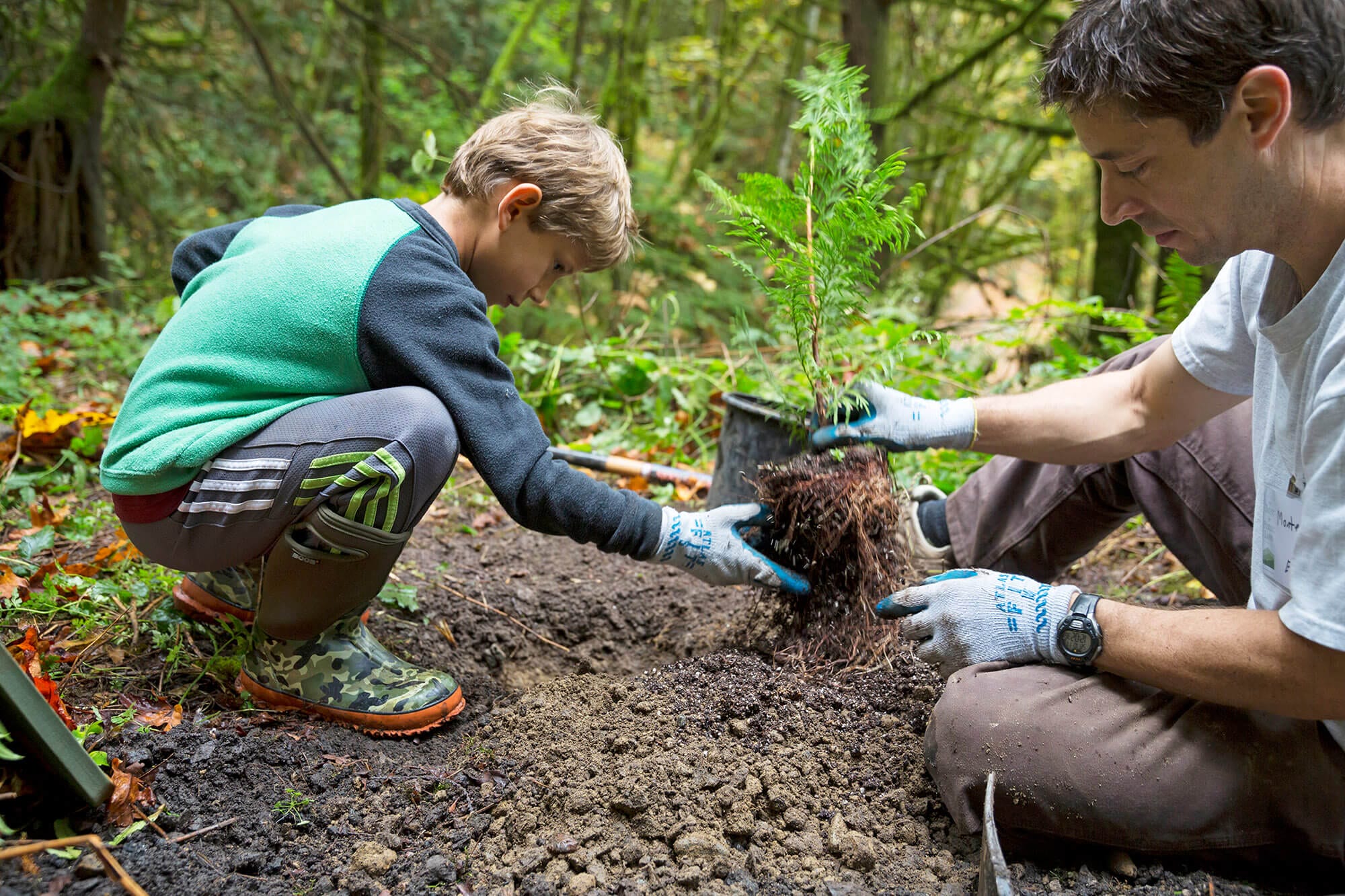As a warming planet leads to worsening risks and impacts, American cities are taking matters into their own hands. Cities are not only pledging to slash carbon emissions in the coming decades. They are also figuring out how to be more resilient. Because one thing is clear: disadvantaged communities that have been historically neglected will suffer the most as the planet warms.
Park acres, it turns out, are very good at buffering the effects of climate change. Green space has the power to lower air temperature and absorb floodwater, and can be designed in such a way as to significantly enhance those climate benefits.
As part of its 2022 ParkScore® index, Trust for Public Land (TPL) asked parks departments in the 100 most populous cities what they’re doing about climate change. Bottom line: many cities are doing a great deal. But cities are not taking action in a vacuum. Neighborhood associations, climate-justice groups, arts organizations, and environmental activists have all pushed cities to move aggressively on climate measures.
[How well is your city meeting the need for parks? Explore the 2022 ParkScore rankings.]
Even where progress is being made, it’s not nearly enough to address the climate crisis, given that many cities lack the funds to adequately care for their parks, let alone invest in major new infrastructure.
We also analyzed access to park space in those same cities, breaking down the results by race/ethnicity and household income. We found:
- Eighty-five percent of cities are adapting parks and recreation facilities to address climate change.
- Eighty percent are enlisting parks to counter urban heat.
- Seventy-six percent are improving surfaces to reduce flooding and runoff from rains.
- Twenty percent are actively managing parks and woodlands to sequester carbon dioxide, the main greenhouse gas responsible for climate change.
- Other cities are managing parks to reduce the risk of wildfire, restoring shorelines to absorb storm surges, and opting for renewable sources of energy.
- Cooling green space is not equitably distributed, however. Trust for Public Land analyzed the 100 most populous cities and found that the neighborhoods where most residents identify as people of color had access to an average of 43 percent less park acreage than predominantly white neighborhoods.
Parks Emerge as Vital Defense
Climate change is bearing down on the world faster than scientists predicted, making life in cities especially challenging. Densely built environments, dominated by concrete and pavement, absorb and hold heat longer than natural landscapes. They are also more prone to flooding as extreme precipitation dumps so-called rain bombs on urban areas that become inundated with dangerous—even lethal—amounts of stormwater.
As damage from climate change escalates in the form of extreme weather, parks and green spaces have an outsized role to play in making cities safe and more livable. Increasingly intense heat waves and heavier rainfalls are becoming more frequent. Cities can design parks with abundant tree canopy and shade structures that keep residents cool in summer and with rain gardens, bioswales, retention ponds, and other nature-inspired solutions that capture stormwater to reduce flooding and improve water quality.
Earlier this year, the Intergovernmental Panel on Climate Change, a group of experts assembled by the United Nations, issued a major new report warning that the ravages of climate change were outpacing the ability of both nature and nations to adapt. The report represented a grim catalogue of the recent toll climate change has taken: storms and floods causing billions of dollars in damage; heat waves killing hundreds in the Pacific Northwest; and extreme heat and droughts leading to crop failures, devastated forests, and threatened water sources. And, the panel cautioned, cities need to rapidly ramp up efforts to protect against these hazards, whether blistering heat waves or sea-level rise.
“Communities are struggling with real threats from the climate crisis, like flooding and extreme heat,” says Diane Regas, president and CEO of Trust for Public Land. “And areas with the least amount of park space, namely communities of color and low-income neighborhoods, suffer the most. The good news is we have the tools to counter some of the worst impacts of climate change by using our public parks and schoolyards.”
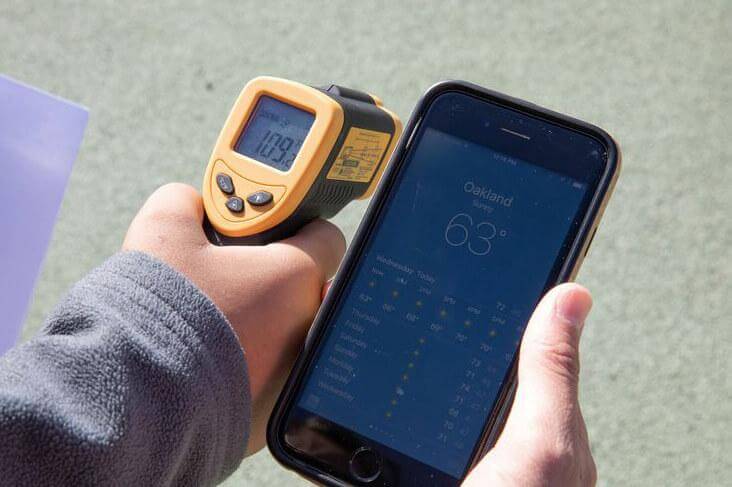
[/media-credit] A student at International Community School in Oakland, California, compares surface and air temperatures on the asphalt schoolyard using a device known as a “heat gun.”
Park agencies in major cities are also taking simple steps to relieve the heat stress experienced by their citizens—such as keeping parks open later in the evening, so children and adults can enjoy the outdoors when heat is less intense, as well as installing splash pads and water misters in playgrounds.
“It’s a pretty incredible range of practices that cities are pursuing to adapt their parks,” says Will Klein, TPL’s project manager for parks research.
Still, transforming parks and green space with climate in mind is expensive. Federal and state funding must be available to cities as they strive to protect residents from the impacts of climate change, especially in vulnerable communities. City governments—largely responsible for funding local park systems—can pursue ballot initiatives and other mechanisms, such as dedicated fees, to generate revenue for their climate projects.

While more needs to be done, some park agencies stand out for their work to make parks—and by extension their cities—better able to withstand the effects of climate change. A recent city ordinance in Des Moines requires that all new (and newly renovated) parks include features that can both capture and filter runoff from heavy rains. Three renovations—at Birdland Park and Marina, Cohen Park, and East Village Park—are being designed with water-retention basins, rain gardens, and bioswales, which are vegetated channels or trenches that hold and filter runoff. (Des Moines is one of the 100 most populous cities included in Trust for Public Land’s annual ParkScore index.)
Moreover, the city will plant 1,500 trees this year, many of them in parks—a substantial increase over last year.
“Parks are extremely important for addressing the urban heat island effect,” says Daniel Calvert, planning and development administrator for the Parks and Recreation Department in Des Moines. “We have seen through studies that where we have green space and vegetated areas, parks are like sponges. They absorb water and reduce heat throughout the city. Fortunately, we have leadership that really gets that and embraces it and funds it.”
In a sign of just how much violent weather has battered the city, parks officials in Des Moines hired a wood carver to make something beautiful from fallen trees, like the ones that came down during the 2020 derecho—a prolonged, severe windstorm. The wood carver used the trunks to fashion climbing structures—one was in the shape of an octopus—for the city’s playgrounds.
Some Cities Are Working to Mitigate Climate Change
While much of the focus in cities is on climate adaptation, a sizable number of parks departments are determined to do their part to stop contributing to climate change. Aware that greenhouse gases cause climate change, park agencies are deploying the weapons at their disposal, namely trees and plants and their carbon-storing superpowers.
It’s true that not every city has a large expanse of forest or woodland within its borders. But according to Brendan Shane, Trust for Public Land’s climate director, every bit of vegetation helps. A 2018 study by University College London found that pockets of urban forest can contain as much carbon as similarly sized areas of tropical rainforest. “All of these natural systems in cities have an impact,” says Shane. “Individual trees growing in schoolyards and groves of trees in parks all capture carbon. Urban green spaces are about resilience, but they are also about climate mitigation and climate justice.”
Residents of cities that do have lots of green space are most likely to experience the full benefits of heat relief. A study conducted by Trust for Public Land in 2020 revealed that communities with nearby parks are dramatically cooler than those in “park deserts.” Our researchers analyzed satellite data for 14,000 cities and towns and found that nationwide, areas within a 10-minute walk of a park are as much as 6 degrees cooler than areas beyond that range.
Our analysis of 14,000 cities and towns shows that nationwide, areas within a 10-minute walk of a park are as much as 6 degrees cooler than areas beyond that range.
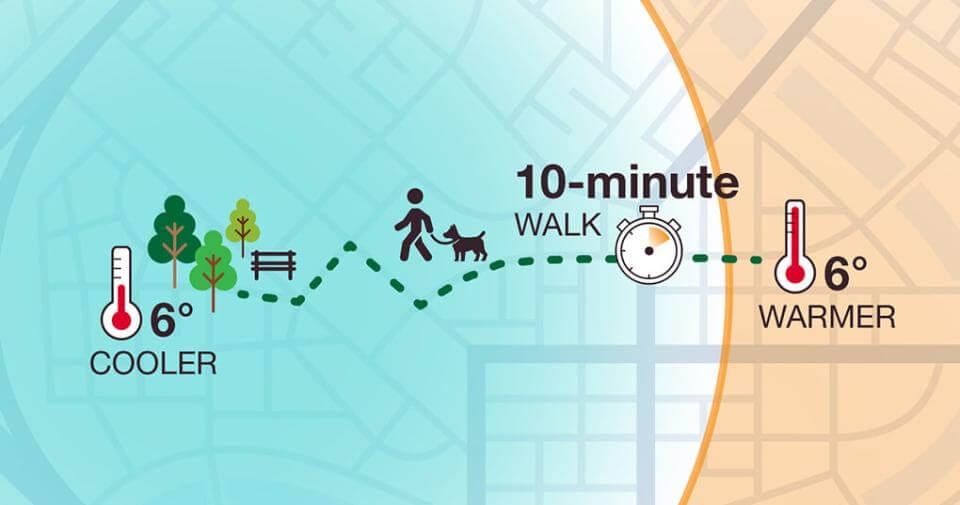
Our analysis of 14,000 cities and towns shows that nationwide, areas within a 10-minute walk of a park are as much as 6 degrees cooler than areas beyond that range.
Greening: Low Tech, High Benefit
That’s an appreciable difference. With heat growing more intense by the year, greening American cities is a low-tech, high-benefit solution to an urgent problem. Over the past 30 years, extreme heat was, on average, the deadliest form of weather, more so than floods, extreme cold, tornadoes, hurricanes, and other events, according to the National Weather Service. Flooding, too, is on the rise. Researchers from Stanford University concluded last year that rainfall fueled by climate change was responsible for almost $75 billion in flood damage in the United States since 1988.
In January 2022, NASA presented its latest findings on global temperatures, with the somber news that eight of the top-10 warmest years on record occurred in the past decade.
And it will only get worse. The Union of Concerned Scientists predicts that, barring a reduction in greenhouse gas emissions, the number of Americans experiencing 30 or more days with a heat index above 105 degrees in an average year will balloon to more than 90 million by mid-century, from fewer than 1 million today.
Verdant spaces can blunt those increases. A pioneering citizen-science project funded by the National Oceanic and Atmospheric Administration (NOAA) in 2018 highlighted nature’s impressive cooling potential. Temperatures in Washington, DC, and Baltimore in August of that year revealed differences of up to 17 degrees between park space and streetscapes dominated by stone, asphalt, and cement. Tellingly, the coolest temperature readings in DC came from deep-green Rock Creek Park and the National Arboretum.
Dr. Vivek Shandas, professor of climate adaptation at Portland State University and an investigator on the NOAA study, has since taken air temperature readings in scores of cities across the United States. “We really need to think about parks as a climate refuge,” he says. “They can improve our resiliency to hotter summers and more extreme precipitation and help us in these times of uncertainty. Especially for communities that don’t have many options for staying cool, parks play a significant role.”
Shandas’s research underscores that when it comes to heat mitigation, dense vegetation outperforms bare lawn. “We actually find that spaces with only grass and no tree canopy don’t make that much of a temperature difference when compared to built-out spaces,” he says. “American lawn culture is so deeply seated in our culture. But we need to find a way for people to go to a park and recognize what a landscape looked like for millennia, with multiple layers of vegetation.”
Educating through Art and Activism
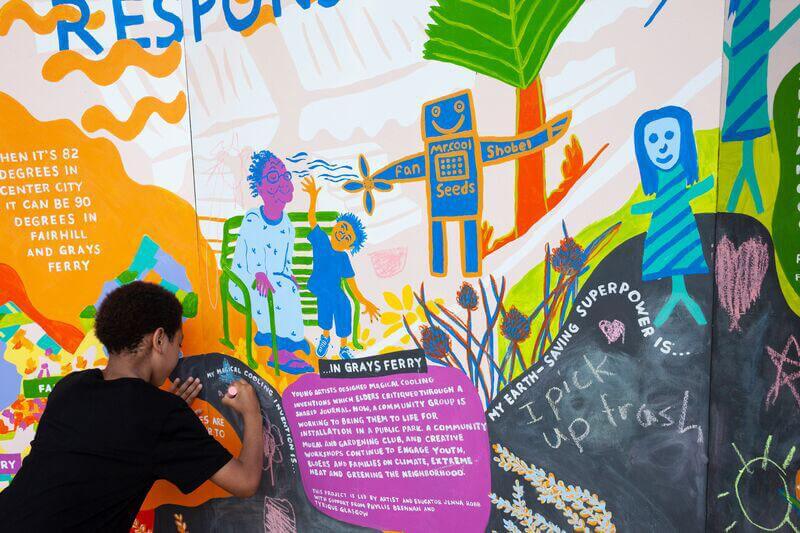
A student puts finishing touches on a TPL mural about urban heat (and the power of green space to combat it) on display at the Philadelphia, Pennsylvania Flower Show at FDR Park in South Philly.
Photo credit: Elyse Leyenberger
Raising awareness about the power of park space to serve as a bulwark against weather extremes is increasingly the work of climate activists and artists. In Philadelphia, Trust for Public Land is funding artists who are working with residents in three neighborhoods with some of the highest temperatures and worst flooding in the city.
Owen Franklin, Pennsylvania state director at Trust for Public Land, says the climate-themed art projects grew out of a detailed map TPL created that pinpoints where urban heat is felt most acutely in the city, along with challenges such as flooding, lack of open space, and obesity. “We see art as a way to connect and strengthen communities, to help residents understand their shared experiences,” he says. “It enables them to work effectively together to demand action from elected officials and become a formidable part of the conversation.”
In southeast Philly, an area rich in cultural diversity but short on green space, Sulay Sosa is an organizer with the Latina Moms initiative. She recently collaborated with the artist José Ortiz-Pagán to highlight the ways urban heat harms the immigrant community. “After I learned more about global warming,” she says, “I felt this is something that affects us all. I believe that sharing information is an act of love.”
In densely developed, older cities like Philadelphia, finding new space to site parks can be difficult. But one overlooked space that is found in practically every neighborhood—the schoolyard—is being put to new use as a community park.
Trust for Public Land has partnered with the School District of Philadelphia to transform nearly a dozen schoolyards in the city. Students help design spaces that inspire play, reduce heat and flooding, and provide outdoor classrooms. Loaded with green infrastructure like absorbent turf fields and bioswales, these Community Schoolyards™ projects also boost park access in the city. That’s because each school agrees to make the schoolyard available to the public after school and on weekends.
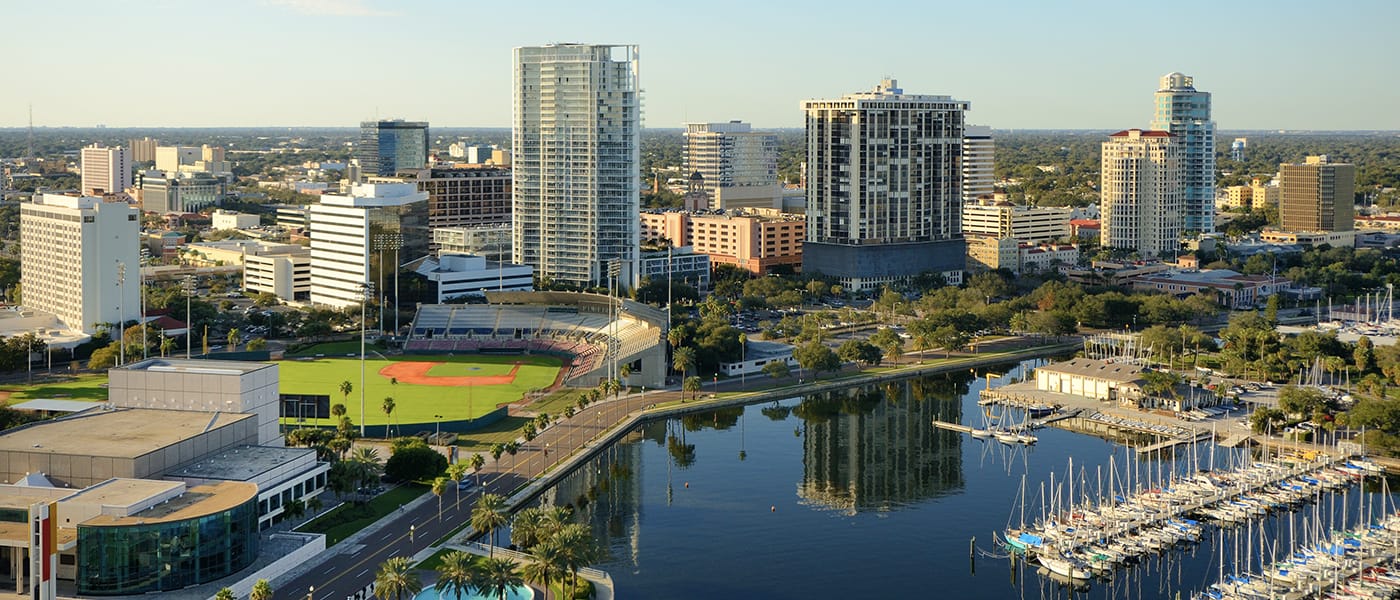
In St. Petersburg, parks officials are waging their own battle against a warming climate. The city’s resilience master plan makes plain that parks are critical in that fight, calling on officials to “plan and design for a future where city green space and parks can serve as a first defense against the vulnerabilities of climate change and storm surge.”
To that end, St. Petersburg recently committed to expanding its tree canopy so that a third of all neighborhoods are shaded by 2035. Last year, it made a down payment on that pledge, planting 1,034 native trees in parks and along streets. With waterfront parks on Tampa Bay and the Intracoastal Waterway, the city is especially attuned to the risks of sea-level rise and rainwater runoff. Currently, work is underway in a few parks and preserves to restore wetlands and create “living shorelines,” both of which absorb storm surges and filter pollutants.
In Lassing Park, which overlooks Tampa Bay, the parks department, in partnership with Tampa Bay Watch, is in the process of installing oyster reefs and planting native grasses along 700 feet of shore to halt erosion triggered by storms and cope with sea-level rise. Presently, the shore consists only of sand.
“The goal is to solidify the shoreline and use oysters to actually clean the water since they act as a natural filtration system,” says Bryan Eichler, assistant director of parks and recreation with the City of St. Petersburg. “When we get a hurricane or tropical storm, it just devastates our shoreline.”
A new Gallup poll found that extreme weather has affected one in three American adults. The findings come from Gallup’s annual Environment poll, conducted in March. (It was the first time Gallup included questions about extreme weather in the poll.) Residents of the South and West were more likely than those in the East or Midwest to report having experienced such weather, which included hurricanes, ice storms, flooding, extreme heat, wildfire, windstorms, and drought.
St. Petersburg Parks and Recreation is also starting to embrace renewable energy. Its main pool complex is heated and cooled with geothermal units that were installed in 2018, and about 10 percent of park bathrooms are now powered with solar panels.
Parks: Where Climate Justice and Environmental Justice Intersect
On the West Coast, Trust for Public Land is involved in two projects that address both climate and environmental justice. One is in Pacoima, a vibrant, predominantly Latinx community in California’s San Fernando Valley dominated by industry and squeezed between freeways. The other is in Bayview–Hunters Point, a predominantly African American, low-income community in San Francisco historically cut off from its industrialized waterfront.
Ronda Chapman, Trust for Public Land’s equity director, says that as a society, we have a “moral imperative” to partner with communities that have been marginalized so they can adapt to rising heat and floodwaters. “You can’t talk about climate without talking about justice,” she explains. “We know that those who are hit first and worst are the people who are low resourced and also end up being socially vulnerable.
“People tend to overlook the reality that these same communities are those that are the least responsible for the human causes of climate change,” Chapman adds. “So often it comes down to investment prioritization. Environmental justice leader Dr. Robert Bullard once said, ‘When you don’t protect the least in your society, you place everybody at risk.’ This is what we have to use as our North Star.”
Recent analyses of historically red-lined neighborhoods around the country have found that those areas suffer from higher rates of air pollution and extreme heat than areas that were not subject to the discriminatory practice. (In the 1930s, banks drew red lines around majority Black neighborhoods they deemed too risky for home mortgages.) Communities of color are also disproportionately affected by severe flooding, as seen during Hurricane Katrina in Louisiana and Hurricane Harvey in Texas.
TPL has found serious disparities in access to the outdoors. In a new analysis of the 100 most-populous cities, neighborhoods where most residents identify as Black, Hispanic and Latinx, American Indian/Alaska Native, or Asian American and Pacific Islander had access to an average of 43 percent less park acreage than predominantly white neighborhoods. Similar park-space inequities existed in low-income neighborhoods across cities.
A Multifaceted Approach to Climate

A child plays on a natural climbing feature in Bradley Plaza, which TPL recently created in the Pacoima section of Los Angeles, California.
Photo credit: Trust for Public Land Staff
In Pacoima, nearly half of the residents live in poverty. Yet the neighborhood abounds in culture, with multigenerational families forging strong connections to the community and to one another. With a landscape marred by hazardous-waste sites, landfills, and autobody shops, temperatures run higher than in other parts of Los Angeles, because of both a microclimate and the lack of green space. When it does rain during the winter months, water comes down in sheets, flooding streets and stranding residents.
A coalition is working to change that. TPL has partnered with Pacoima Beautiful and other groups to make the community more resilient in the face of climate change. With funding from California’s Transformative Climate Communities grant program, the Pacoima initiative, known as the Green Together Collaborative, involves upgrades to existing park space, thousands of new street trees, the repair of broken sidewalks, and installation of climate-friendly features such as electric vehicle charging stations.
Previously, Trust for Public Land had worked with the community to convert a street into a pedestrian open space, called Bradley Plaza and Green Alley, with new trees and a giant shade structure. We also transformed the adjacent alley into an attractive thoroughfare, with planting beds engineered to absorb and filter stormwater before it flows to the aquifer below.
“Heat and water are our big issues in Southern California,” says Robin Mark, program director in Los Angeles at Trust for Public Land. “We don’t have enough water and, when it does rain, we don’t do a good enough job of capturing it and infiltrating it. Most of it goes out to the ocean. It’s also hot most of the time. There was a day last year in Pacoima where it got up to 117 degrees. The focus of this grant program is to help Pacoima become more climate adaptive.”
In San Francisco, a spectacular green space on the bay is rising from a former brownfield and an adjacent, though rundown, park. When completed, the 10-acre India Basin Shoreline Park will offer boat access, as well as lawns, piers, and a floating dock for enjoying the bay.
Natural basins are incorporated into the design to reduce stormwater runoff—and thus, nutrient pollution—in the bay. The upland areas will feature drought-tolerant coastal sage and grasses. “The big idea for this park is to soften the shoreline by taking out the riprap and walls,” says Shannon Nichol, founding principal of GGN, the landscape architecture firm overseeing the project.
Maps projecting sea-level rise over the next 50 to 100 years led designers to establish fixed piers above the anticipated high-water mark in 2070. The design also takes into account the inevitable loss of park acreage closest to the water as sea levels climb in the coming decades. Plans call for the lawn to retreat as water encroaches, for example.
Strengthening Communities
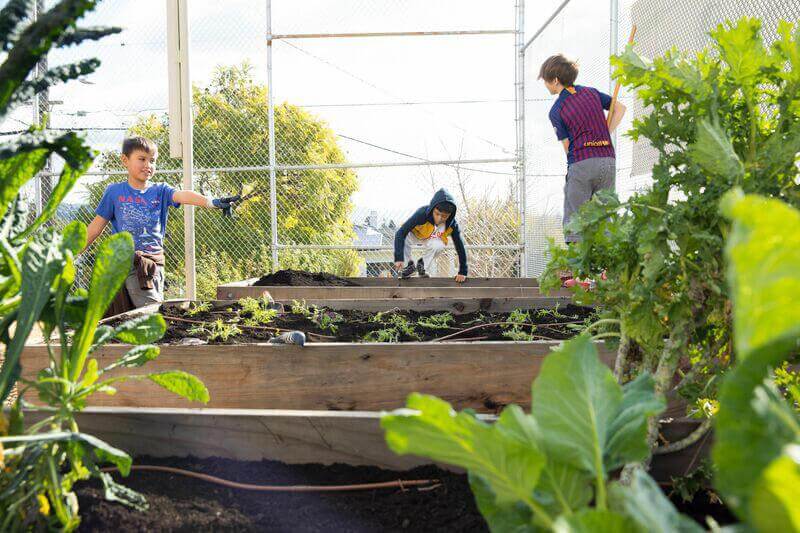
Students planting in raised garden beds at Melrose Leadership Academy, a public elementary school in Oakland, California, where TPL helped reimagine the schoolyard.
Photo credit: Angela DeCenzo
As much as the designers are trying to address sea-level rise, community partners and the city are working to strengthen the neighborhood—economically, socially, and politically. To achieve that, the project is being guided by the India Basin Equitable Development Plan. The plan was created by the community with technical assistance from Trust for Public Land, San Francisco Parks Alliance, A. Philip Randolph Institute, and San Francisco Recreation and Parks Department.
Among other things, the plan acknowledges and seeks to correct historic and systemic environmental injustices within Bayview–Hunters Point. It also provides resources to support community organizing and capacity building among residents. And it offers workforce development in the form of construction-job training, along with a tech hub. The hub has already opened in the existing park, with free Wi-Fi, loaner laptops, and tech support.
“If you don’t address equity, you’re not going to move the needle on climate or environmental justice,” says Jackie Flin, executive director of the A. Philip Randolph Institute San Francisco, a social-justice organization that is helping shepherd the India Basin Shoreline Park project.
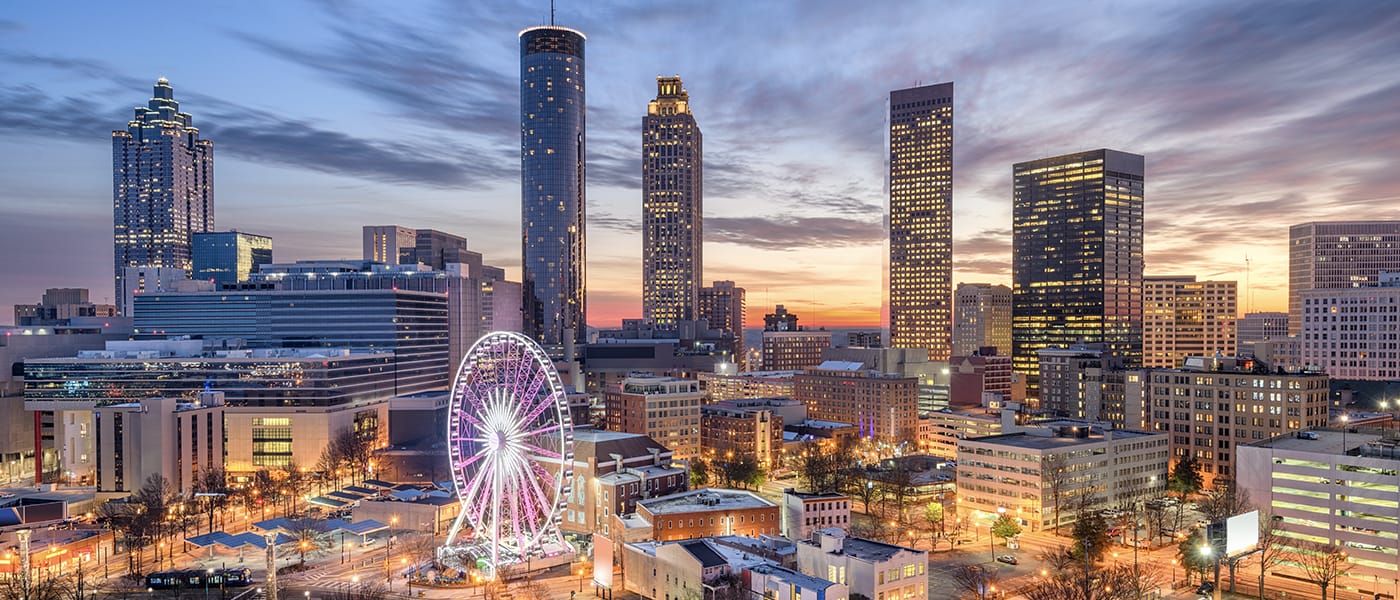
Perhaps no green space offers a better case study for dealing with flooding than Cook Park in Atlanta. Spearheaded by Trust for Public Land, the 16-acre park opened last spring in Vine City, a neighborhood long plagued by floods. Twenty years ago, torrential rains unleashed flash floods that toppled or damaged dozens of homes. Sixty homes were razed and many residents left the area for good. Still, the community remained at risk, given its location at the edge of downtown Atlanta, covered by buildings and pavement.
To avoid a repeat of the Vine City disaster, the new park features a raft of green infrastructure elements that complement its 2-acre retention pond. Combined, these elements can manage up to 9 million gallons of rainwater per storm. The park recently won three engineering awards from the American Council of Engineering Companies of Georgia.
Todd Hill, a deputy commissioner with the Atlanta Department of Watershed Management, says Cook Park exemplified what the city is trying to achieve more broadly. “We are dedicated to managing stormwater,” he says, “and we’ve invested significantly in green infrastructure to support these goals across the city.”
Because of the elaborate engineering and design work, Cook Park’s more functional side doubles as a beguiling landscape. In the southeast corner of the park, for instance, fountains and pools draw visitors who are likely unaware that the waterworks also aerate and filter rainwater runoff.
“Every park that has green space will have some floodwater benefits,” says Taj Schottland, associate director of TPL’s national climate program, noting that grass and soil naturally absorb water. “But when you start to design parks with flood reduction in mind, that’s when you start to see these really significant benefits.”
By Mapping the Problem, We Can Pinpoint the Solutions
Sophisticated mapping, like the kind developed by Trust for Public Land’s team of data scientists, can help cities identify where best to focus their energy in adapting neighborhoods. Linda Hwang, TPL’s senior director of strategy and innovation, explained that heat and public health data, as well as census information, now allow for more refined and revealing maps. “Our spatial analyses can show which neighborhoods have the least amount of park acreage,” she says, “and also where new and existing park space can help address extreme heat, flooding, and other challenges like low physical-activity levels and poor mental health.”
In New York City, for instance, we have transformed 218 asphalt schoolyards into neighborhood parks. All of TPL’s Community Schoolyards projects include trees and plants, but nearly a quarter were designed specifically with green infrastructure to combat heat and sop up floodwater. Together, they capture more than 40 million gallons of water annually. The sponge-like schoolyards help prevent combined sewer overflows, in which the sewer system becomes overwhelmed during even moderate rains, discharging raw sewage directly into bays and rivers.
After the devastation from Hurricane Ida last September, when streets in New York City turned into rivers and residents drowned in basement apartments, the city committed anew to protecting people from the impacts of climate change. Weather stations in the city recorded more than 3 inches of rain in a single hour, shattering previous records.
New funding from New York City in the aftermath of Ida will enable Trust for Public Land to remake another 20 schoolyards over the next four years; they will be intentionally designed to absorb water in flood-hazard areas. (That is on top of 15 green-infrastructure schoolyards TPL had already planned to renovate, using funding from the city’s Department of Environmental Protection, the agency responsible for water quality.)
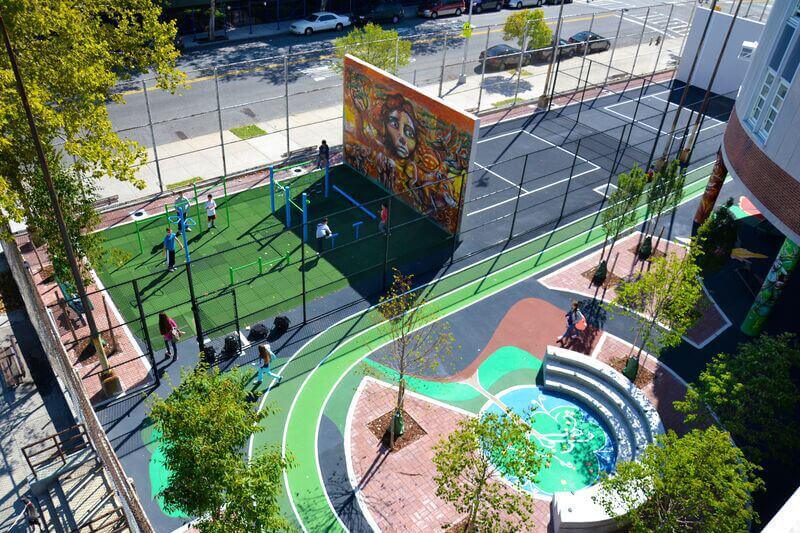
The 20 planned schoolyards sit within 500 feet of locations known for “extreme nuisance flooding,” while some are within 250 feet, says Carter Strickland, vice president of the mid-Atlantic region and New York state director at Trust for Public Land. Four schoolyards will break ground this year—two in Manhattan, one in the Bronx, and one in Brooklyn. Given the heat island effect permeating the city’s concrete canyons, the Community Schoolyards initiative will also provide much-needed cooling for schoolchildren and the wider community.
“Our hardscape just radiates heat and sheds water,” says Strickland, who formerly served as commissioner of the city’s Department of Environmental Protection. “This will have a real, immediate impact. Everyone knows that on a hot day you want to sit under a shade tree. What we plant today will provide shade for a lifetime.”
While major cities like New York and San Francisco can afford to hire landscape architects well-versed in climate adaptation, that is not necessarily the case in smaller cities. That’s one reason the National Recreation and Park Association (NRPA) is offering an online course on managing floodwater, geared toward park planners, public works professionals, community groups, and advocates. Participants in the Green Stormwater Infrastructure program will receive a certificate upon completion.
“Our course explores the ways parks can be part of the solution around stormwater infrastructure,” says Ayanna Williams, director of community and environmental resilience for NRPA. “There are 10 modules that cover everything from how you engage the community and create a budget to various kinds of green infrastructure, from bioswales to green roofs.”
Creativity around natural climate solutions—using nature and green infrastructure to address climate risks—was evident in the responses to this year’s survey by Trust for Public Land. Klein, TPL’s project manager for parks research, oversees the survey of the 100 most populous cities. He tallied a list of 470 parks—from Chesapeake, Virginia, to Fremont, California—that, in one way or another, protect against climate change.
But deploying the full suite of strategies requires money. Congress and state governments need to help cities by investing in parks, trees, trails, and other nature-based solutions—especially in communities that need them most. Cities themselves should consider ballot measures to generate new revenue for the purpose of creating and enhancing parks. In fact, a record 35 of the 100 ParkScore cities now have voter-approved park bonds or other dedicated park-funding sources in place. Such investments will bridge the park equity gap, reduce urban heat, and prevent flooding caused by climate change.
For Howard Frumkin, senior vice president at Trust for Public Land and a leading expert on public health and sustainability, the innovative thinking applied to parks and climate is yielding another positive outcome. In a word: hope.
“If you can awaken in kids a connection with nature, which then inspires constructive engagement on the climate crisis, that is a powerful defense against despair and hopelessness,” says Frumkin, who coedited Planetary Health: Protecting Nature to Protect Ourselves. “There is something magical about parks, which is that they inspire people, and that inspiration translates to hopefulness.”

